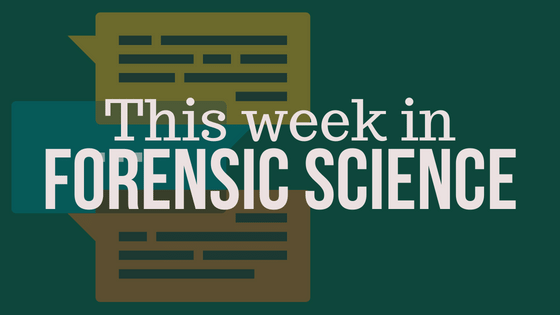No one has hours to scour the papers to keep up with the latest news, so we’ve curated the top news stories in the field of Forensic Science for this week. Here’s what you need to know to get out the door!
DNA Profiles Recovered from Former Indiana Home of Suspected Serial Killer (WISHTV.com – 7/20/2023)
Forensic Technology Grad is an Award-Winning Investigator (University of New Haven – 7/21/2023)
For Marissa DelConte ’19 M.S., her passion for forensic science led her to the University of New Haven and, after graduating, to Florida to begin her career. Her work is already making an important impact, and she has been recognized for her excellence and dedication to her field.
Discarded DNA: The Controversial Clue in the Trash that’s Bringing Serial Killers to Justice (USA Today – 7/21/2023)
The Long Island Gilgo Beach murder case is one of many in recent years when a long-unsolved homicide got a break from an unlikely source: discarded DNA.
The case illuminates a tactic that is a growingly important weapon in the arsenal of police detectives across the nation: grabbing publicly available, private DNA – off abandoned food, soda cans, car doors, even cigarette butts – that belongs to suspected killers.
The process is called “surreptitious DNA collection.”
USA TODAY talked to forensic science experts about the DNA strategy authorities are using and its efficacy and practice. They said the process is common and a helpful tool that can help authorities pin down those who they are already suspicious of to connect them to a dangerous crime.
Tennessee Bureau of Investigation Teams with Othram to Identify 1985 Homicide Victim (DNASolves – 7/21/2023)
In March 1985, skeletal remains were discovered near a creek bank by a motorist who was having vehicle trouble along Interstate 24 West between mile markers 29 and 30 in Cheatham County, Tennessee. Tennessee Bureau of Investigation (TBI) agents began investigating the woman’s death alongside the Cheatham County Sheriff’s Office. Forensic anthropologists at the University of Tennessee determined that the skeletal remains were those of a white female. According to the University of Tennessee Anthropology Department, the woman was estimated to have been deceased for two to five months prior to the discovery of her remains. After exhausting all leads, investigators could not determine the victim’s identity, and she became known as “Cheatham County Jane Doe.”
In April 2018, the University of Tennessee Forensic Anthropology Center submitted a sample of the woman’s remains to the University of North Texas Center for Human Identification (UNTCHI). A DNA profile was developed and entered into the Combined DNA Index System (CODIS) and the National Missing and Unidentified Persons System (NamUs) in hopes that the woman would eventually be identified. Despite these efforts, the woman’s identity remained a mystery. The case was entered into NamUs as UP1578.
In December 2022, as part of the TBI Unidentified Human Remains DNA Initiative, TBI submitted highly degraded skeletal remains to Othram’s laboratory in The Woodlands, Texas in hopes of identifying the woman. Othram developed a suitable DNA extract and then used Forensic-Grade Genome Sequencing® to build a comprehensive DNA profile for the unknown woman. Once a profile was built, Othram’s in-house genetic genealogy team used forensic genetic genealogy to provide TBI agents with investigative leads.
National Forensic Investigators Re-Opening Cold Cases with New DNA Techniques (NL Times – 7/23/2023)
The Netherlands Forensic Institute (NFI) is adopting a new DNA matching technique that it tested over the past two years, NOS reported on Friday. This technique, which automatically compares DNA profiles with a database, will now become standard in forensic investigations and could reopen cold cases.
50 potential offenders were identified during the trial period using this technique. The identified matches are related to serious crimes, including violent crimes, drug offenses, shootings, kidnappings, and vice cases.
The new system significantly improves the utilization of “bad” DNA profiles. These are incomplete profiles or those contaminated with DNA from other people. These were previously manually compared with the DNA database and often overlooked after one comparison. With the new method, these “bad” profiles are automatically compared with the database, increasing the chances of a match.
New DNA Tests Cast Doubt on Convictions in Decades-Old Murder (The Washington Post – 7/23/2023)
Shively Police Department Teams with Othram to Identify 2005 Jane Doe (DNASolves – 7/23/2023)
Bitemark Evidence Can Send Wrong Person to Prison, Death Row, UB Professors Say (University at Buffalo – 7/24/2023)
Investigators Doing DNA Testing on Human Remains Recovered from Titan Submersible (CBC – 7/25/2023)
2023 International Symposium on Human Identification (ISHI) Keynote Offers Message of Resilience for Forensics Professionals (BusinessWire – 7/25/2023)
A Man Fell Into an Abandoned Elevator Shaft 40 Years Ago. He Was Just Identified. (WCNC – 7/25/2023)
WOULD YOU LIKE TO SEE MORE ARTICLES LIKE THIS? SUBSCRIBE TO THE ISHI BLOG BELOW!
SUBSCRIBE NOW!


